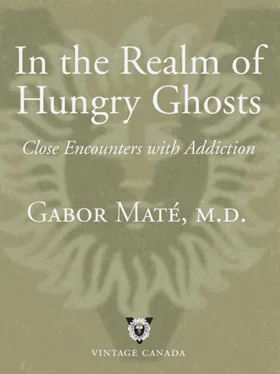To ensure that babies can make their way out of the birth canal, the bargain forced upon our ancestors was that the human brain would be relatively small and immature at birth. On the other hand, it would undergo tremendous growth outside the mother’s body. In the period following birth, the human brain, unlike that of the chimpanzee, continues to grow at the same rate as in the womb. There are times in the first year of life when, every second, multiple millions of nerve connections, or synapses, are established. Three-quarters of our brain growth takes place outside the womb, most of it in the early years. By three years of age, the brain has reached 90 per cent of adult size, whereas the body is only 18 per cent of adult size. 4This explosion in growth outside the womb gives us a far higher potential for learning and adaptability than is granted to other mammals. Were we born with our brain development rigidly predetermined by heredity, the frontal lobes would be limited in their capacity to help us learn and adapt to the many different environments and social situations we humans now inhabit.
Greater reward demands greater risk. Outside the relatively safe environment of the womb, our brains-in-progress are highly vulnerable to potentially adverse circumstances. Addiction is one of the possible negative outcomes—although, as we will see when we discuss genetic influences, the brain can already be negatively affected in the uterus in ways that increase vulnerability to addiction and to many other chronic conditions that threaten health.
The dynamic process by which 90 per cent of the human brain’s circuitry is wired after birth has been called “neural Darwinism” because it involves the selection of those nerve cells (neurons), synapses and circuits that help the brain adapt to its particular environment, and the discarding of others. In the early stages of life, the infant’s brain has many more neurons and connections than necessary—billions of neurons in excess of what will eventually be required. This overgrown, chaotic synaptic tangle needs to be trimmed to shape the brain into an organ that can govern action, thought, learning and relationships and carry out its multiple and varied other tasks—and to coordinate them all in our best interests. Which connections survive depends largely on input from the environment. Connections and circuits used frequently are strengthened, while unused ones are pruned out: indeed, scientists call this aspect of neural Darwinism synaptic pruning. “Both neurons and neural connections compete to survive and grow,” write two researchers. “Experience causes some neurons and synapses (and not others) to survive and grow.” 5
Through this weeding out of unutilized cells and synapses, the selection of useful connections and the formation of new ones, the specialized circuits of the maturing human brain emerge. The process is highly specific to each individual person—so much so that not even the brains of identical twins have the same nerve branching, connections and circuitry. In large part, an infant’s early years define how well her brain structures will develop and how the neurological networks that control human behaviour will mature. “Developmental experiences determine the organizational and functional status of the mature brain,” writes child psychiatrist and researcher Bruce Perry. 6Or in the words of Dr. Robert Post, chief of the Biological Psychiatry Branch of the [U.S.] National Institute of Mental Health: “At any point in this process you have all these potentials for either good or bad stimulation to get in there and set the microstructure of the brain.” 7And it is precisely here where the problem arises for young children who will, in adolescence and beyond, become chronically hooked on hard drugs: too much of what Dr. Post called bad stimulation. This is true of the hardcore intravenous drug users such as the ones I deal with in the Downtown Eastside. In many other cases it’s not a question of “bad stimulation” but of a lack of sufficient “good stimulation.”
Our genetic capacity for brain development can find its full expression only if circumstances are favourable. To illustrate this, just imagine a baby who was cared for in every way but kept in a dark room. After a year of such sensory deprivation the brain of this infant would not be comparable to those of others, no matter what his inherited potential. Despite perfectly good eyes at birth, without the stimulation of light waves, the thirty or so neurological units that together make up our visual sense would not develop. The neural components of vision already present at birth would atrophy and become useless if this child did not see light for about five years. Why? Neural Darwinism. Without the requisite stimulation during the critical period allotted by Nature for the visual system’s development, the child’s brain would never have received the information that being able to see is needed for survival. Irreversible blindness would be the result.
What is true for vision is also true for the dopamine circuits of incentive-motivation and the opioid circuitry of attachment-reward, as well as for the regulatory centres in the prefrontal cortex, such as the orbitofrontal cortex—in other words, for all the major brain systems implicated in addiction that we surveyed in the previous three chapters. In the case of these circuits, which process emotions and govern behaviour, it is the emotional environment that is decisive. By far the dominant aspect of this environment is the role of the nurturing adults in the child’s life, especially in the early years.

The three environmental conditions absolutely essential to optimal human brain development are nutrition, physical security and consistent emotional nurturing. In the industrialized world, except in cases of severe neglect or dire poverty, the baseline nutritional and shelter needs of children are usually satisfied. The third prime necessity—emotional nurture—is the one most likely to be disrupted in Western societies. The importance of this point cannot be overstated: emotional nurturance is an absolute requirement for healthy neurobiological brain development. “Human connections create neuronal connections”—in the succinct phrase of child psychiatrist Daniel Siegel, a founding member of UCLA’s Center for Culture, Brain and Development. 8As we will soon see, this is particularly so for the brain systems involved in addiction. The child needs to be in an attachment relationship with at least one reliably available, protective, psychologically present and reasonably nonstressed adult.
Attachment, as we’ve already learned, is the drive to pursue and preserve closeness and contact with others; an attachment relationship exists when that state has been achieved. It’s an instinctual drive programmed into the mammalian brain, owing to the absolute helplessness and dependency of infant mammals—particularly infant humans. Without attachment he cannot survive; without safe, secure and nonstressed attachment, his brain cannot develop optimally. Although that dependency wanes as we mature, attachment relationships remain important throughout our lifetime.
Daniel Siegel writes in The Developing Mind:
For the infant and young child, attachment relationships are the major environmental factors that shape the development of the brain during its period of maximal growth…Attachment establishes an interpersonal relationship that helps the immature brain use the mature functions of the parent’s brain to organize its own processes. 9
To begin to grasp the matter, all we need to do is picture a child who was never smiled at, never spoken to in a warm and loving way, never touched gently, never played with. Then we can ask ourselves: What sort of person do we envision such a child becoming?
Читать дальше













